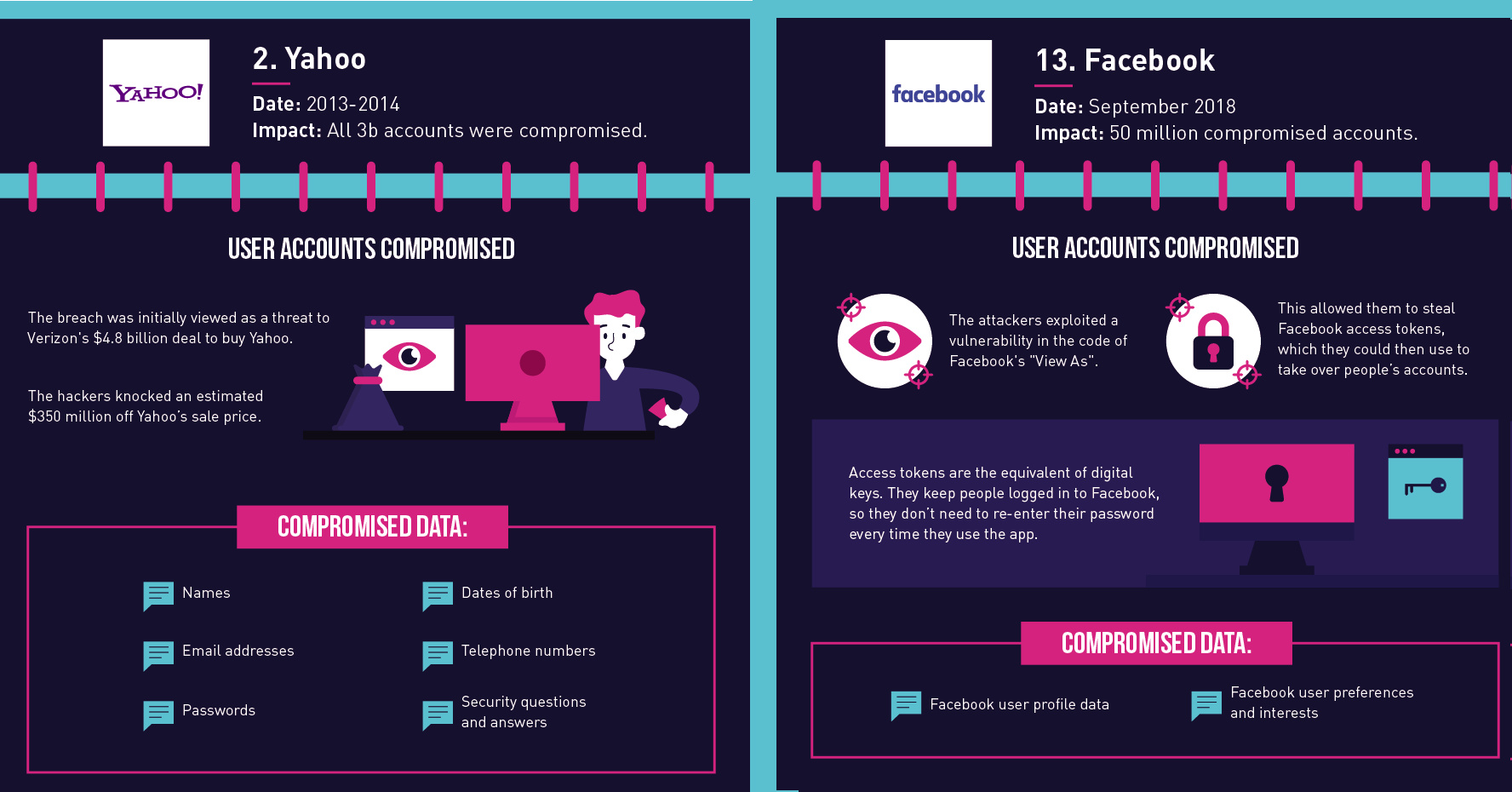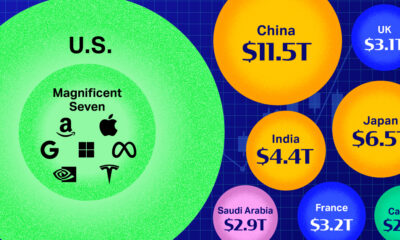Technology
The 15 Biggest Data Breaches in the Last 15 Years
There’s no doubt that data breaches are a primary concern for people on the technological side of any modern business.
However, it’s increasingly the case that C-suite executives are catching wind of the potential business ramifications that these breaches can trigger.
In 2013, for example, the hacking of Yahoo not only compromised three billion email accounts – it also nearly jeopardized Verizon’s bid to acquire the company for $4.8 billion. At the end of the day, experts say that the breach knocked $350 million off of the sale price of Yahoo.
Counting Down the Breaches
Today’s infographic comes to us from Hosting Tribunal, and it highlights the biggest data breaches over the last 15 years.

Did you know that a whopping 14,717,618,286 records have been stolen since 2013?
It’s part of a much larger problem, and some experts anticipate that by 2021 the cost of cybercrime to the global economy will eclipse $6 trillion – a potential impact that would even supersede the size of the current Japanese economy ($4.9 trillion).
The 15 Biggest Data Breaches
Here are the most notable breaches that have occurred over the last 15 years, in ascending chronological order:
| Year | Company | Impact |
|---|---|---|
| 2004 | AOL | 92 million screen names and email addresses stolen |
| 2013 | Yahoo | All 3 billion accounts compromised |
| 2013 | Target | 110 million compromised accounts, incl. 40 million payment credentials |
| 2014 | eBay | 145 million compromised accounts |
| 2015 | Anthem Inc | 80 million company records were hacked, including Social Security numbers |
| 2016 | 117 million emails and passwords leaked | |
| 2016 | MySpace | 360 million compromised accounts |
| 2016 | Three | 133,827 compromised accounts, including payment methods |
| 2017 | Equifax | 143 million accounts exposed, including 209k credit card numbers |
| 2016 | Uber | 57 million compromised accounts |
| 2018 | Marriott | 500 million compromised accounts |
| 2018 | Cathay Pacific | 9.4 million compromised accounts, including 860k passport numbers |
| 2018 | 50 million compromised accounts | |
| 2018 | Quora | 100 million compromised accounts |
| 2018 | Blank Media | 7.6 million compromised accounts |
Most of these breaches led to millions, or even billions, of records being compromised.
And while the motives behind cyberattacks can vary from case to case, the business impact of hacks at this scale should make any executive tremble.
Technology
Ranked: Semiconductor Companies by Industry Revenue Share
Nvidia is coming for Intel’s crown. Samsung is losing ground. AI is transforming the space. We break down revenue for semiconductor companies.
Semiconductor Companies by Industry Revenue Share
This was originally posted on our Voronoi app. Download the app for free on Apple or Android and discover incredible data-driven charts from a variety of trusted sources.
Did you know that some computer chips are now retailing for the price of a new BMW?
As computers invade nearly every sphere of life, so too have the chips that power them, raising the revenues of the businesses dedicated to designing them.
But how did various chipmakers measure against each other last year?
We rank the biggest semiconductor companies by their percentage share of the industry’s revenues in 2023, using data from Omdia research.
Which Chip Company Made the Most Money in 2023?
Market leader and industry-defining veteran Intel still holds the crown for the most revenue in the sector, crossing $50 billion in 2023, or 10% of the broader industry’s topline.
All is not well at Intel, however, with the company’s stock price down over 20% year-to-date after it revealed billion-dollar losses in its foundry business.
| Rank | Company | 2023 Revenue | % of Industry Revenue |
|---|---|---|---|
| 1 | Intel | $51B | 9.4% |
| 2 | NVIDIA | $49B | 9.0% |
| 3 | Samsung Electronics | $44B | 8.1% |
| 4 | Qualcomm | $31B | 5.7% |
| 5 | Broadcom | $28B | 5.2% |
| 6 | SK Hynix | $24B | 4.4% |
| 7 | AMD | $22B | 4.1% |
| 8 | Apple | $19B | 3.4% |
| 9 | Infineon Tech | $17B | 3.2% |
| 10 | STMicroelectronics | $17B | 3.2% |
| 11 | Texas Instruments | $17B | 3.1% |
| 12 | Micron Technology | $16B | 2.9% |
| 13 | MediaTek | $14B | 2.6% |
| 14 | NXP | $13B | 2.4% |
| 15 | Analog Devices | $12B | 2.2% |
| 16 | Renesas Electronics Corporation | $11B | 1.9% |
| 17 | Sony Semiconductor Solutions Corporation | $10B | 1.9% |
| 18 | Microchip Technology | $8B | 1.5% |
| 19 | Onsemi | $8B | 1.4% |
| 20 | KIOXIA Corporation | $7B | 1.3% |
| N/A | Others | $126B | 23.2% |
| N/A | Total | $545B | 100% |
Note: Figures are rounded. Totals and percentages may not sum to 100.
Meanwhile, Nvidia is very close to overtaking Intel, after declaring $49 billion of topline revenue for 2023. This is more than double its 2022 revenue ($21 billion), increasing its share of industry revenues to 9%.
Nvidia’s meteoric rise has gotten a huge thumbs-up from investors. It became a trillion dollar stock last year, and broke the single-day gain record for market capitalization this year.
Other chipmakers haven’t been as successful. Out of the top 20 semiconductor companies by revenue, 12 did not match their 2022 revenues, including big names like Intel, Samsung, and AMD.
The Many Different Types of Chipmakers
All of these companies may belong to the same industry, but they don’t focus on the same niche.
According to Investopedia, there are four major types of chips, depending on their functionality: microprocessors, memory chips, standard chips, and complex systems on a chip.
Nvidia’s core business was once GPUs for computers (graphics processing units), but in recent years this has drastically shifted towards microprocessors for analytics and AI.
These specialized chips seem to be where the majority of growth is occurring within the sector. For example, companies that are largely in the memory segment—Samsung, SK Hynix, and Micron Technology—saw peak revenues in the mid-2010s.
-

 Mining2 weeks ago
Mining2 weeks agoCharted: The Value Gap Between the Gold Price and Gold Miners
-

 Real Estate1 week ago
Real Estate1 week agoRanked: The Most Valuable Housing Markets in America
-

 Business1 week ago
Business1 week agoCharted: Big Four Market Share by S&P 500 Audits
-

 AI1 week ago
AI1 week agoThe Stock Performance of U.S. Chipmakers So Far in 2024
-

 Misc1 week ago
Misc1 week agoAlmost Every EV Stock is Down After Q1 2024
-

 Money2 weeks ago
Money2 weeks agoWhere Does One U.S. Tax Dollar Go?
-

 Green2 weeks ago
Green2 weeks agoRanked: Top Countries by Total Forest Loss Since 2001
-

 Real Estate2 weeks ago
Real Estate2 weeks agoVisualizing America’s Shortage of Affordable Homes














